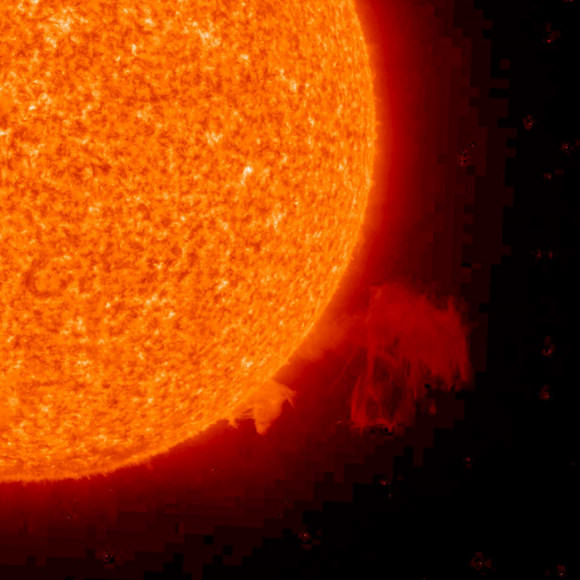The current solar cycle (24) has been pretty boring, but a new sunspot — 1035 — is growing rapidly and now is seven times wider than Earth. Solar astronomers are predicting it could grow to be the largest sunspot of the year. There’s not been a lot of competition for the biggest sunspot, though: for 259 days (or 74%) of 2009, the sun has been spotless. But maybe the (solar) tide is turning. There’s been other action recently besides the new sunspot. A long-duration C4-class solar flare erupted this morning at 0120 UT from around the sunspot, which hurled a coronal mass ejection (CME) towards Earth. (See below for image of the CME that blasted off the sun on Dec. 14) Observers at high-latitude could see some aurora action when the CME arrives on or about Dec. 18th. Keep cheering; maybe the sun will come out of its doldrums.

Remember, don’t look at the Sun directly to try and see the sunspot. NASA has a great site that gives real-time data and updated images of the Sun from SoHO (Solar and Heliospheric Observatory.) Or check out Spaceweather.com, which also provides updates. And if you have a safe way of observing and imaging the sunspot, feel free to post images here, or send to Nancy.


Any way to predict where the CME will be causing aurora’s? Finally saw my first one here in Minnesota during winter a few years ago, would love to see it again.
SuperKevin,
Check out the Spaceweather.com site (link above) for current info on aurora. Not only is there a current image of the auroral circle over North America and all sorts of pertinent solar data, but CME alerts are posted there too. There’s an alert out now for a CME expected to reach us on or about Dec. 18. Wish I had better prospects for aurora here in Florida, but you never know!
NASA’s Solar Dynamics Observatory is set to launch in January, just in time to catch this new solar cycle. Much improved imaging capability over SOHO, natch.
I wouldn’t be too enthusiastic for a too active solar cycle. Remember, there are astronauts in a glorified set of tin cans up in space exposed to any solar flares!